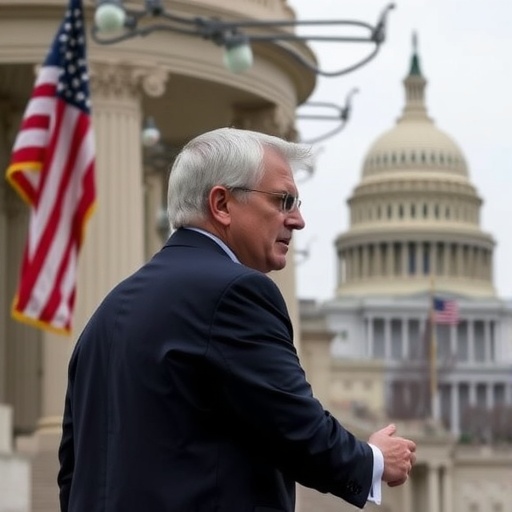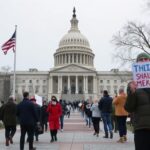As the U.S. Government shutdown stretches into its 26th day, federal workers are scraping by without paychecks, and Treasury Secretary Scott Bessent is sounding the alarm on looming economic disaster if Congress doesn’t act fast. This prolonged impasse, the longest since 2018-2019, has left over 800,000 federal employees furloughed or working without compensation, amplifying calls for bipartisan compromise amid finger-pointing from both sides of the aisle.
- Federal Employees Grapple with Unpaid Bills and Uncertainty
- Congressional Finger-Pointing Escalates Amid Stalled Budget Talks
- Scott Bessent’s Direct Appeal to Moderate Democrats Ignites Hope
- Economic Warnings Mount as Shutdown Threatens Broader Fallout
- Prospects for Resolution: Bipartisan Breakthrough or Prolonged Standoff?
Federal Employees Grapple with Unpaid Bills and Uncertainty
The human cost of the Government shutdown is mounting daily, with stories of financial desperation emerging from coast to coast. In Washington, D.C., Smithsonian curator Maria Gonzalez, a single mother of two, has already dipped into her savings to cover rent and groceries. “It’s terrifying not knowing when the next paycheck will come,” Gonzalez told reporters outside the National Mall, where cherry blossoms mock the barren federal offices. According to the Office of Personnel Management, approximately 2.1 million federal workers are affected, including 800,000 who are furloughed and another 1.3 million essential personnel toiling without pay.
Statistics paint a grim picture: A recent survey by the National Treasury Employees Union revealed that 40% of affected workers have less than $500 in emergency savings, forcing many to rely on food banks, credit cards, or side gigs like driving for rideshares. In California, air traffic controllers at major airports are among those working unpaid, raising safety concerns as fatigue sets in. The Federal Aviation Administration has reported no major incidents yet, but experts warn that prolonged stress could lead to errors. “These aren’t just numbers; they’re families on the brink,” said union president Doreen Greenwald in a statement released yesterday.
Beyond immediate hardships, the shutdown’s ripple effects are hitting local economies. Small businesses near federal installations, such as those in Quantico, Virginia, report a 20-30% drop in revenue, per a U.S. Chamber of Commerce analysis. Veterans’ services are disrupted too, with the Department of Veterans Affairs delaying some benefits processing, leaving thousands of ex-servicemen waiting for critical support. This isn’t the first rodeo—during the 35-day shutdown of 2018-2019, back pay took weeks to distribute, exacerbating the pain. As day 26 dawns, whispers of morale collapse among federal ranks are growing louder, with absenteeism rates spiking in essential services.
Congressional Finger-Pointing Escalates Amid Stalled Budget Talks
In the marbled halls of Capitol Hill, the blame game is in full swing as Republicans and Democrats trade barbs over the Government shutdown‘s origins. House Speaker Mike Johnson (R-La.) accused Democrats of “obstructing national security funding” during a fiery press conference on Wednesday, pointing to disagreements over border wall allocations and disaster relief packages. “The Democrats are holding the American people hostage for their radical agenda,” Johnson declared, vowing no concessions without stricter immigration controls.
Democrats fired back, with Senate Majority Leader Chuck Schumer (D-N.Y.) labeling the Republican stance “partisan sabotage.” In a Senate floor speech, Schumer highlighted how the impasse stems from GOP demands to tie shutdown avoidance to unrelated policy riders, including cuts to green energy subsidies. “This isn’t governance; it’s gamesmanship at the expense of everyday Americans,” he said. The core dispute revolves around a $1.2 trillion omnibus spending bill, where Democrats push for expanded social safety nets, while Republicans insist on fiscal restraint and defense boosts.
Negotiations have ground to a halt, with the latest bipartisan working group dissolving after just two sessions last week. Sources close to the talks reveal that moderate Republicans, like Sen. Susan Collins (R-Maine), are frustrated but unwilling to break ranks. Meanwhile, progressive Democrats, including Rep. Alexandria Ocasio-Cortez (D-N.Y.), have rallied against any compromise that doesn’t include climate funding, further complicating the path forward. A Congressional Budget Office report estimates the shutdown has already cost the economy $11 billion in lost productivity, with daily damages now exceeding $400 million. As partisan lines harden, public approval ratings for Congress have plummeted to 18%, according to a Gallup poll released today.
Scott Bessent’s Direct Appeal to Moderate Democrats Ignites Hope
Treasury Secretary Scott Bessent, a Wall Street veteran turned Trump administration appointee, stepped into the fray with a pointed plea yesterday, urging moderate Democrats to bypass party hardliners and broker a deal. In an exclusive interview with CNBC, Bessent warned, “The economy can’t afford this paralysis. Moderate Democrats in swing districts hold the key—reach across the aisle before it’s too late.” His comments, delivered from the Treasury’s imposing headquarters, underscore the administration’s strategy to isolate fiscal conservatives on the left.
Bessent, known for his pragmatic approach to fiscal policy, detailed the shutdown’s drag on growth. “We’ve seen consumer confidence dip by 5 points this month alone,” he noted, citing Federal Reserve data. He specifically name-checked Sens. Joe Manchin (I-W.Va.) and Kyrsten Sinema (I-Ariz.), former Democrats now independents, as potential swing votes. “These leaders have shown independence before; now’s the time to do it again,” Bessent urged. His outreach comes amid reports of private calls to moderate House Democrats, promising flexibility on non-core issues like infrastructure spending.
The secretary’s intervention marks a shift from earlier White House rhetoric, which had leaned heavily on executive orders to mitigate impacts. Bessent also addressed international concerns, noting that foreign investors are watching closely. “A prolonged government shutdown signals instability to global markets,” he said, referencing a 2% dip in the Dow Jones last week tied to shutdown fears. Democrats’ response has been mixed: While progressives dismissed it as “pressure tactics,” centrists like Rep. Josh Gottheimer (D-N.J.) expressed openness, tweeting, “Bipartisanship is the only way out.” Bessent’s gamble could either thaw the freeze or deepen divides, depending on Capitol Hill’s reaction.
Economic Warnings Mount as Shutdown Threatens Broader Fallout
The economy, already navigating inflation and supply chain woes, faces amplified risks from the government shutdown, with experts projecting up to $18 billion in total damages if it extends beyond 30 days. Moody’s Analytics forecasts a 0.3% shave off first-quarter GDP growth, driven by halted IRS tax processing and delayed Small Business Administration loans. “This isn’t just a Washington problem; it’s a national economic drag,” said Mark Zandi, chief economist at Moody’s, in a Bloomberg op-ed.
Key sectors are reeling: National parks, closed for weeks, have lost $500 million in visitor spending, per the National Park Service. Food safety inspections by the FDA are down 15%, sparking worries over potential outbreaks. In the financial realm, the shutdown has frozen $40 billion in federal grants, stalling research at universities and nonprofits. Wall Street’s reaction has been jittery—a S&P 500 futures drop of 1.2% yesterday reflected investor unease. Bessent echoed these concerns in his testimony before the House Financial Services Committee, stating, “Every day without resolution chips away at our economic resilience.”
Longer-term, credit rating agencies like Fitch are monitoring closely, with whispers of a potential downgrade if the impasse persists. Historical parallels are stark: The 2013 shutdown cost $24 billion and contributed to a debt ceiling crisis. Today’s stakes feel higher amid post-pandemic recovery, with unemployment ticking up 0.2% in federal-heavy regions like Maryland. Businesses are adapting—Amazon and Uber have offered jobs to furloughed workers—but the patchwork solutions can’t replace systemic stability. As stock markets wobble and consumer spending cools, the pressure on Congress intensifies.
Prospects for Resolution: Bipartisan Breakthrough or Prolonged Standoff?
Looking ahead, the path out of the government shutdown remains murky, but glimmers of progress could emerge from unexpected quarters. With midterm elections looming, vulnerable Democrats in red-leaning districts may heed Bessent’s call, potentially forcing a vote on a short-term funding bill by week’s end. White House officials hint at a “clean CR” (continuing resolution) as a compromise, stripping out contentious riders to reopen agencies immediately.
However, hardliners on both sides show no signs of budging. Republican leadership has scheduled closed-door caucuses for Friday, aiming to unify their bloc, while Democrats plan strategy sessions with the Congressional Progressive Caucus. If talks fail, President Biden could invoke emergency powers for limited operations, but legal challenges would likely follow. Analysts predict a 60% chance of resolution within 10 days, per PredictIt markets, buoyed by public outrage—polls show 72% of Americans blame Congress equally.
The stakes extend beyond borders: Allies like the EU are delaying trade talks, citing U.S. instability. Domestically, a breakthrough could restore confidence, but escalation might trigger credit warnings or even recessionary signals. As federal workers rally outside the Capitol today, chanting “Pay Us Now,” the onus is on leaders to prioritize people over politics. Whether Bessent’s outreach sparks a thaw or the shutdown drags into April remains the billion-dollar question, with the economy hanging in the balance.








